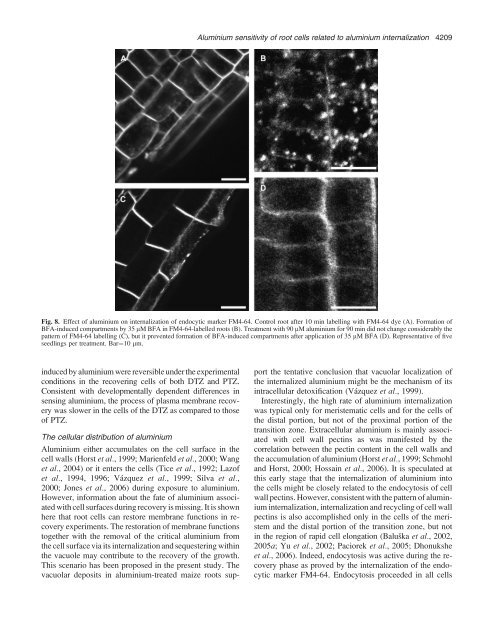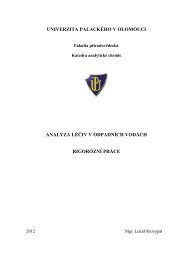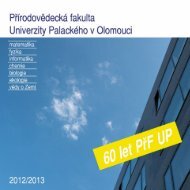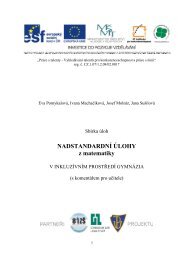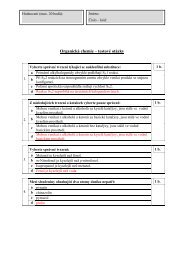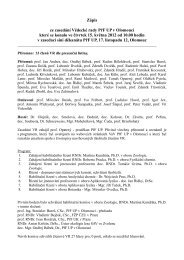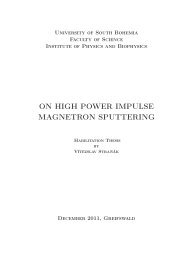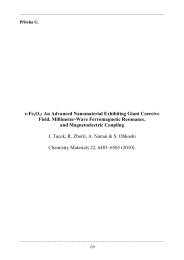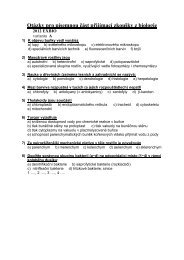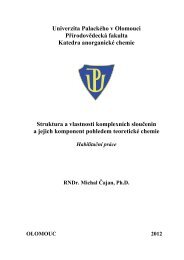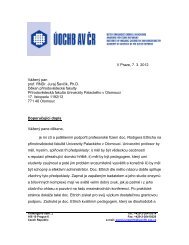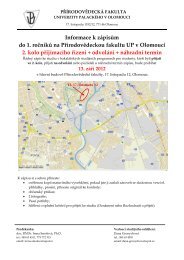A comparative structural analysis of direct and indirect shoot ...
A comparative structural analysis of direct and indirect shoot ...
A comparative structural analysis of direct and indirect shoot ...
Create successful ePaper yourself
Turn your PDF publications into a flip-book with our unique Google optimized e-Paper software.
Aluminium sensitivity <strong>of</strong> root cells related to aluminium internalization 4209<br />
Fig. 8. Effect <strong>of</strong> aluminium on internalization <strong>of</strong> endocytic marker FM4-64. Control root after 10 min labelling with FM4-64 dye (A). Formation <strong>of</strong><br />
BFA-induced compartments by 35 lM BFA in FM4-64-labelled roots (B). Treatment with 90 lM aluminium for 90 min did not change considerably the<br />
pattern <strong>of</strong> FM4-64 labelling (C), but it prevented formation <strong>of</strong> BFA-induced compartments after application <strong>of</strong> 35 lM BFA (D). Representative <strong>of</strong> five<br />
seedlings per treatment. Bar¼10 lm.<br />
induced by aluminium were reversible under the experimental<br />
conditions in the recovering cells <strong>of</strong> both DTZ <strong>and</strong> PTZ.<br />
Consistent with developmentally dependent differences in<br />
sensing aluminium, the process <strong>of</strong> plasma membrane recovery<br />
was slower in the cells <strong>of</strong> the DTZ as compared to those<br />
<strong>of</strong> PTZ.<br />
The cellular distribution <strong>of</strong> aluminium<br />
Aluminium either accumulates on the cell surface in the<br />
cell walls (Horst et al., 1999; Marienfeld et al., 2000; Wang<br />
et al., 2004) or it enters the cells (Tice et al., 1992; Laz<strong>of</strong><br />
et al., 1994, 1996; Vázquez et al., 1999; Silva et al.,<br />
2000; Jones et al., 2006) during exposure to aluminium.<br />
However, information about the fate <strong>of</strong> aluminium associated<br />
with cell surfaces during recovery is missing. It is shown<br />
here that root cells can restore membrane functions in recovery<br />
experiments. The restoration <strong>of</strong> membrane functions<br />
together with the removal <strong>of</strong> the critical aluminium from<br />
the cell surface via its internalization <strong>and</strong> sequestering within<br />
the vacuole may contribute to the recovery <strong>of</strong> the growth.<br />
This scenario has been proposed in the present study. The<br />
vacuolar deposits in aluminium-treated maize roots support<br />
the tentative conclusion that vacuolar localization <strong>of</strong><br />
the internalized aluminium might be the mechanism <strong>of</strong> its<br />
intracellular detoxification (Vázquez et al., 1999).<br />
Interestingly, the high rate <strong>of</strong> aluminium internalization<br />
was typical only for meristematic cells <strong>and</strong> for the cells <strong>of</strong><br />
the distal portion, but not <strong>of</strong> the proximal portion <strong>of</strong> the<br />
transition zone. Extracellular aluminium is mainly associated<br />
with cell wall pectins as was manifested by the<br />
correlation between the pectin content in the cell walls <strong>and</strong><br />
the accumulation <strong>of</strong> aluminium (Horst et al., 1999; Schmohl<br />
<strong>and</strong> Horst, 2000; Hossain et al., 2006). It is speculated at<br />
this early stage that the internalization <strong>of</strong> aluminium into<br />
the cells might be closely related to the endocytosis <strong>of</strong> cell<br />
wall pectins. However, consistent with the pattern <strong>of</strong> aluminium<br />
internalization, internalization <strong>and</strong> recycling <strong>of</strong> cell wall<br />
pectins is also accomplished only in the cells <strong>of</strong> the meristem<br />
<strong>and</strong> the distal portion <strong>of</strong> the transition zone, but not<br />
in the region <strong>of</strong> rapid cell elongation (Baluška et al., 2002,<br />
2005a; Yuet al., 2002; Paciorek et al., 2005; Dhonukshe<br />
et al., 2006). Indeed, endocytosis was active during the recovery<br />
phase as proved by the internalization <strong>of</strong> the endocytic<br />
marker FM4-64. Endocytosis proceeded in all cells


